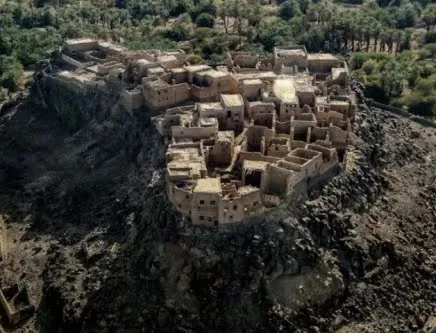According to the most recent updates, archaeologists have found a fortified settlement that is approximately 4,000 years old in Northwest Saudi Arabia, referred to as al-Natah, which is located in the beautifully walled Khaybar Oasis in the desert. This is relevant because it shows how societies transitioned from a nomadic to a more sedentary way of life.
 |
| (Photo Credit: Mohammad QASIM / AFP) Ancient 4,000-Year-Old Fortified Town Unearthed In Saudi Arabia |
Read More: Andhra Pradesh To Launch First Seaplane Trial, Connecting Vijayawada And Srisailam
The discovery included a 14.5-kilometer wall that surrounded the settlement which has the research led by French archaeologist Guillaume Charloux. After analyzing the archaeological extracts published in the PLOS One journal, it was concluded that the town site was created about 4,400 years ago where it was about 500 inhabitants at that place. The article states that a 2.6-hectare settlement commenced construction roughly between 2400 and 2000 BC has been located and collapsed before 1500 BC and probably as late as 1300 BC, although it might have had interruptions.
Furthermore, it has been reported that this settlement, around 4000 years old, underwent a different process of urbanisation and provided examples of how early Arabian cultures developed from pastoral nomadism into sociably structured cities.
Unlike the concentric large urban zones, al-Natah is characterized by a 'slow urbanism' process where organized small groups inhabited the desert and slowly built their surroundings.
Through satellite imagery, archaeologists were able to study al-Natah and were able to detect the presence of house foundations, and pathways that indicated advanced architectural features such as support for multi-storied buildings. Pottery fragments were found as well, indicating a society that was not wealth driven but rather social in nature. While the presence of metal relics shows they were metal crafters and connecting al-Natah trading relations with other areas, as well as a very large cemetery which features unique ‘step tower’ design burials shows sophisticated burial customs.
Additionally, the presence of the fortified enclosure around the habitation revealed the importance of protection from possible invasions, suggesting a sophisticated social structure. As suggested by Charloux, the function of al-Natah as a fortified oasis might have facilitated those traversing the desert, therefore, aiding the early trade networks. This way of life modification to fit the unfriendly desert region was a strategic interplay of old ways of living as nomads and the new life of cities.
In contrast to the swift growth that occurred in Mesopotamia and Egypt, the case of al-Natah has a gradual urbanization that implies a different kind of social evolution in northwest Arabia. The researchers have praised the investigation, underlining its role in the analysis of landscapes of early Arabian cities development. In the opinion of Charloux, the long-term evolution of al-Natah delineates another urbanism – that of marginality and endurance. Although al-Natah was later deserted from approximately 1500 to 1300 B.C, the place remains vital in tracing the evolution of the sociocultural and economic landscape of the area.



.jpg)

%20(1).jpg)

0 Comments
Do Share Your Views